Over the past four months, I tore down my lifelong learning system to the studs and rebuilt it from the ground up with a focus on scale. As I described in A Virtuous Cycle vs. Walled Gardens for Lifelong Learning:
To build a lifelong learning system that scales, I shifted away from top-down walled gardens, organized by topics, towards a bottom-up virtuous cycle, focused on ideas, which increases in value as the number of ideas grows.
I did this because I strongly felt there had to be a more effective way to learn in a scalable way. I wanted a system that generated exponential returns on prior knowledge.
For context, I lived in 18 places during my first 21 years. That experience was great for learning how to meet people and adapt to change. Less so for building an excellent educational foundation. Looking back, I now know that I quickly became good at learning how to pass a test at the expense of long-term knowledge.
My biggest issue with learning is we approach it linearly. We start with a class and then learn topics and ideas. But then the bell rings, and we head to our next class. Then we learn topics and ideas. But then the bell rings, and you can guess where this ends. We end the day with a binder with isolated topics and ideas for each class. And we are incentivized to learn this information primarily for exams, without much incentive to retain it for future classes. This approach is linear because each idea belongs to one topic and class.
What I propose in this system works the other way—the ideas matter the most. Get the atomic level (i.e., the lowest-level possible) ideas down pat and then connect topics and classes. This approach is exponential because each idea can belong to multiple topics and classes.
This article is guidance for what works well for me after four months of research and experimentation. I hope that it helps you, too. The primary components of this system are Zettelkasten, automation tools, and a scalable learning process. In the end, I go through multiple sample workflows.
Disclaimer: I have no affiliation with any of the companies below. I do include a referral link for products if one exists, although please do not feel pressured to use them.
Zettelkasten Overview
Niklas Luhmann was a German sociologist and prominent thinker in systems theory who created the Zettelkasten method. Zettelkasten, German for “slip box,” is a tool for thinking, writing, and connecting thoughts across disciplines. It emphasizes connection, not the collection. (Wikipedia, 2022a).
Niklas built a Zettelkasten of 90,000 index cards and credited it with his extraordinary productivity of more than 70 books and 400 scholarly articles.
A few months ago, I read through all types of personal knowledge management systems. What caught my eye with Zettelkasten was how Niklas said his productivity stemmed from working in a partnership with the system. (Sascha, 2020). By linking atomic ideas to each other, he found he was thinking with the system, which reduced friction for writing. He discovered topics to write about while looking through his connected ideas and used his notes to write his articles and books.
Atomic ideas are the cornerstone of the system
Atomic refers to something that cannot be broken down into smaller parts. It is easier to connect a single idea across various contexts by distilling knowledge into its atomic ideas.
A Zettelkasten workflow emphasizes connecting atomic ideas
At the risk of over-simplification, the Zettelkasten workflow is:
- Capture quick thoughts in fleeting notes.
- Turn highlights and fleeting notes into literature notes.
- Create permanent notes of atomic ideas from your literature notes — only one idea per note — in your words.
- Connect permanent notes to other permanent notes and structure notes for different contexts.
- Write using your permanent notes. It is lovely how articles and topics seem to write themselves as your system grows.
I go through several real-world examples later in this article. So do not worry too much about seeing how the workflow fits you yet.
Fleeting notes capture quick thoughts
I capture fleeting notes haphazardly. I always have my phone on me, and I email myself about something that I want to explore later. Or I will write it down in Notability if I take notes during a meeting. (Side note: I hand-write notes during meetings. It feels too impersonal to type while someone is talking.) While reading, I add notes in Kindle or Pocket.
The location and method are not relevant. Use what is best for you that feels natural. What is critical is that you have a system for processing your fleeting notes.
Literature notes integrate highlights and fleeting notes
Literature notes are your highlights, notes, and summaries of books, articles, videos, and other content. Literature notes are flexible, and how you use them is up to you. I like to highlight verbatim and add manual notes while I read. Later, when reviewing the literature note to create permanent notes, I rewrite and summarize them in my own words. Ahrens (2017) says to keep literature notes concise by being selective and using your own words while consuming the content.
Experiment to see what works best for you.
Permanent notes are your atomic ideas
To make a permanent note, review your fleeting and literature notes while focusing on how they relate to other ideas and contexts. And write in your own words! Connect your permanent notes to different contexts by linking to additional permanent notes and adding to structure notes. (Ahrens, 2017).
At first, I resisted creating truly atomic ideas and too often fell back to copy-pasting. I felt it was too time-consuming. And, no surprise, I started building walled gardens again.
How do you know that you are on the right track? An excellent permanent note is understandable even when you have forgotten the original context. Furthermore, you will see patterns with an atomic idea appearing across contexts.
For example, here is a permanent note about the Zeigarnik effect. Since I created this atomic idea, I have found it in three books and articles. (Ignore the TARGET DECK and START syntax. That is for creating Anki cards with your notes. See the spaced repetition sample workflow for more.)
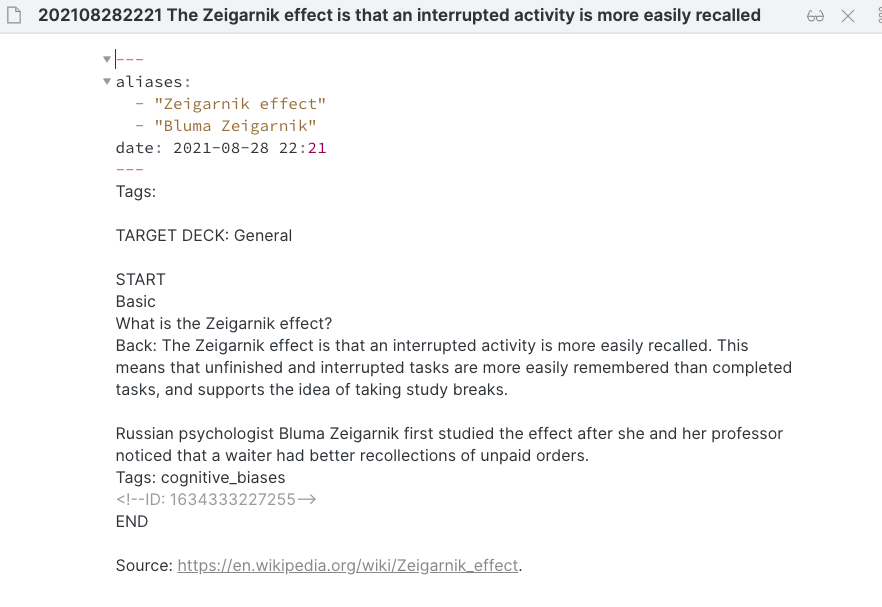
Structure notes give context to permanent notes
Structure notes—sometimes called index notes—create an entry point into a line of thought or topic. A structure note is a collection of linked permanent notes in one document. For example, here is my structure note for Zettelkasten. Nothing fancy, and expect these to evolve as you add more atomic ideas to the system.
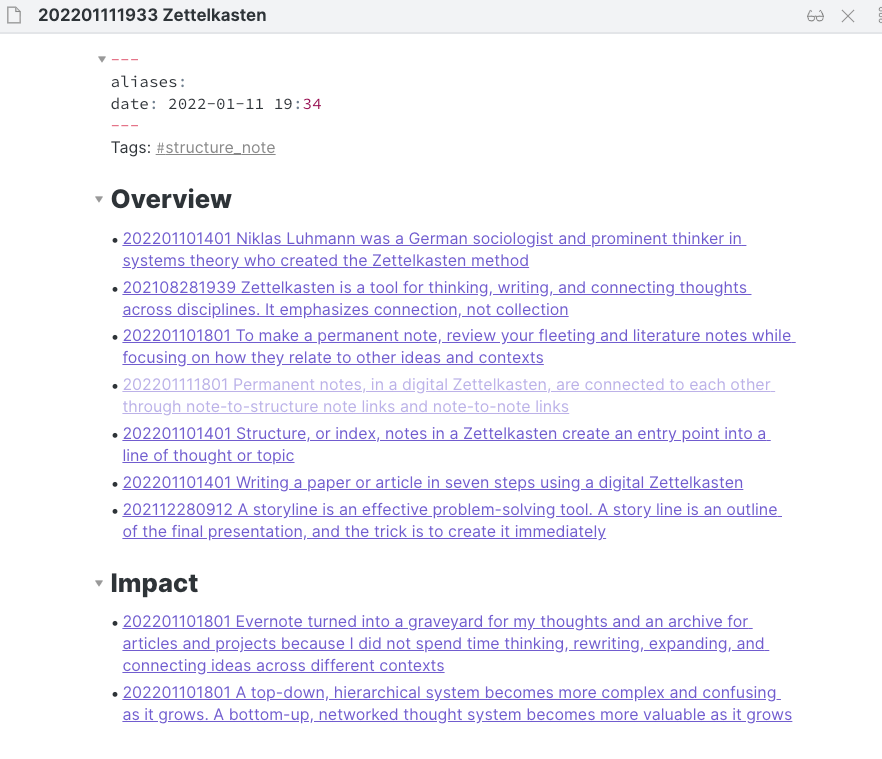
Required and Optional Tools
It is more important to understand the concepts and how they work together to facilitate lifelong learning. For example, Niklas used this system with hand-written flashcards. The data scientist in me shivers thinking about this system without modern automation. However, the best system is the one that you use. Below are the tools that work best for me after experimenting over the past four months. I would love to hear what works for you as you explore the system.
Knowledge management supports the capturing, clarifying, and comprehending components of the system
The knowledge management tools used, in order of importance, are:
- Obsidian: A knowledge base built on local plain text markdown files. Free for personal use and $8/month for sync. Obsidian is the core tool for this system. Alternatives include Roam Research, Notion, and pen and paper. I chose Obsidian because the file format is not proprietary, and the Discord community is remarkable. There is an energy around this software that I do not see in others, and I want to grow with it.
- Anki: An open-source spaced repetition system with digital flashcards. Free for personal use. Anki is the core tool for spaced repetition and self-testing, and it integrates with Obsidian. Alternatives include Quizlet and pen and paper.
- Pocket (optional): Capture and highlight articles. Free for basic use and $5/month for premium features, including unlimited search and long-term storage. Alternatives include Instapaper and Evernote.
- Readwise (optional): Sync your reading highlights across Kindle, Pocket, iBooks, and more. Readwise automatically creates literature notes based on my highlights.
- LanguageTool (optional): Proofreading. It is open-source and integrates with Obsidian. Free for basic use and $5/month for premium features. The primary alternative is Grammarly.
- Hemingway Editor (optional): Editor for writing clarity. A one-time $20 purchase. I use Hemingway for some articles to help reduce wordiness and complexity.
- Forvo (optional): Downloadable word pronunciations. Free for personal use. I use Forvo for my vocabulary cards.
Productivity and measurement provide feedback for how you are spending your time
The productivity and measurement tools used, in order of importance, are:
- Google Calendar (optional): Digital calendar with good integrations. I use a calendar for time blocking. Free for personal use.
- RescueTime (optional): Automatically track and get insights on how you spend your time on apps and websites. $12/month for premium features. Alternatives include Toggl and Harvest.
- Zapier (optional): A no-code platform to integrate with thousands of sites and apps. Free for limited use and $20/month for more apps and connections. The primary alternative is IFTTT.
- Shortcuts on Apple Watch (optional): Automate tasks with your apps. Free for personal use. I use a custom shortcut to add items to my calendar, and then Zapier filters specific items to send to RescueTime. For example, I click “Read” and then “25 minutes” so that RescueTime captures my offline reading time.
- Focus (optional): Create focused Pomodoro sessions. $5/month for unlimited use. The primary alternative is a timer.
The Learning Process
Now the fun begins! Let us combine the concepts and tools and walk through each stage of the lifelong learning virtuous cycle. A virtuous cycle is when chains of events reinforce themselves through a feedback loop. And each iteration of the cycle reinforces the prior cycle.

Capture: More effective consumption and storage of knowledge
I am grateful that I am a fast reader. And it became a handicap when I built this system. I found myself adding too many fleeting and literature notes without going through them and creating atomic ideas. Now, I find myself skimming more and deciding to stop a lousy book earlier than I used to. What is the point if I cannot find the time or motivation to review what I capture?
A tip that helped me highlight less is to ask myself the value of something six months from now. If the value is not immediately apparent, I keep going.
I use a custom Apple shortcut to add items to my calendar to track my capture time, and then Zapier filters specific items to send to RescueTime. For example, I click “Read” and then “25 minutes” so that RescueTime captures my offline activities. I rarely use the Kindle on the PC, although when I do, RescueTime captures it.
Some specifics for different media types:
- Books: I try to read books more than anything else because the quality is higher, on average, maximizing my learning time. I use the Kindle for digital books, and Readwise imports my highlights and notes into Obsidian. I use Readwise’s app for paper books, and their tool is called “Paper Books.”
- Articles: I send all articles to Pocket, where I then highlight and add notes. Readwise imports my highlights and notes into Obsidian.
- Podcasts: I do not have a suitable method for capturing podcasts. I tried Airr, which syncs to Readwise, and it was too buggy for me.
- Meetings: I hand-write notes during meetings on an iPad with Notability. Lately, the Apple Pencil recognition is getting better to where I am exploring taking notes in Obsidian.
Clarify: Create and iterate on atomic ideas
Clarifying your thoughts to create and iterate on atomic ideas takes time and effort. I use time blocking and Pomodoro to add pressure, which helps me go through my fleeting and literature notes more efficiently.
Why do I add some pressure? Parkinson’s Law states that work expands to fill the time available for its completion. In other words, people do not take as much time as they need for a task — they take as much time as they have. It was a tongue-in-cheek joke in The Economist in the 50s referring to the growth of bureaucracy, and has since been confirmed in academic studies. (Henselmans, 2021).
Time blocking, which appears to have originated in Deep Work by Cal Newport, explicitly divides your day into time blocks. The key is planning your day while balancing how much to block versus how much to keep open. Supposedly, Bill Gates and Elon Mask plan their day in 5-minute intervals. I am skeptical of this, and even if true, you and I are not Bill or Elon.
Pomodoros are focused work sessions that promote sustained concentration, alternated with frequent breaks. (Scroggs, n.d.-b). Focused means closing your email and other distractions and turning off notifications. It sucks to lose focus if you are in a flow state, and I find it very difficult to get back on track quickly. I use 25-minute work sessions with 5-minute breaks. After four work sessions, I take a 20-minute break, if possible. If you are an individual contributor or technical lead, I recommend experimenting with 55-minute work sessions. A 25-minute session feels too short when I am in a great flow state; however, my role requires little coding these days, so I learned to focus on shorter sprints.
Time blocking and Pomodoro are two of many productivity methods. I recommend you experiment until you find what works best for you. Not sure about different approaches? Take the productivity methods quiz at Todoist.
Comprehend: Add context to your ideas and remember with spaced repetition
How we learn in school is ineffective for comprehension and long-term memory. In school, we retain a lot of information on specific topics quickly. And we are incentivized to memorize this information primarily for exams. This approach means we learn to pass a test without a system for retaining information beyond the exam, inhibiting growth in lifelong learning.
Connect your atomic ideas and structure notes to add context. One generally starts with context (i.e., a specific course) and then adds notes in school. As you create atomic ideas and link them to each other, and structure notes, you begin to develop your topics and lines of thinking from the bottom-up. See what connects, what is missing, and what needs clarification. This approach helps immensely with comprehension.
Regarding retention, German psychologist Hermann Ebbinghaus discovered the spacing effect in 1885. He observed that we remember things more effectively if we spread out reviews over time. In 1985, SuperMemo pioneered the concept of a system that keeps track of the ideal time to review material and optimizes reviews for each user. The perfect time to review depends on how well you can remember the item. Since a memory gets stronger each time you successfully recall it, the time between reviews gets bigger and bigger. Without a decrease in recall, this increased time between reviews means you can maximize the amount of material you learn with the least amount of effort. (Anki Manual, n.d.).
Anki further explains that active recall testing is trying to remember the answer when asked a question. On the other hand, passive study is when you consume information without pausing to consider if you know the answer. Research shows that active recall testing is far superior at building strong memories than passive study for two reasons:
- The act of recalling something strengthens the memory.
- The act of not recalling something is a sign that you need to revisit the material to review or relearn it.
I found that spaced repetition only works if you write in your own words on topics you have learned. Avoid downloading shared decks!
I turn almost every atomic idea into an Anki card.
Communicate: Share and sharpen your ideas
Writing is the most effective way to think through an idea and create compelling narratives with sound logic. A significant advantage of writing is that it forces you to confront yourself if you do not understand a topic as well as you think you do. Explaining what you are learning in your own words is deliberate practice with a feedback loop. (Perell, n.d.). I believe learning through writing is a vastly underrated concept. What feels like rational thoughts in your head or a beautiful set of PowerPoint slides often breaks down when you write.
Ahrens (2017) put it nicely when describing why people struggle with writing. They stumble because they learn that writing starts with a blank page. Writing begins with good notes. And it is immensely easier to write when you gather well-written notes than assembling everything in your mind.
Compound: Connect ideas across contexts and build upon your knowledge
It is too common to overestimate the importance of a single event and to underestimate the importance of consistent, small changes. A small change, compounded over time, has an extraordinary impact. Over a year, improving by one percent each day leads to a 37x improvement! And declining by one percent each day reduces to nearly zero. [1] (Clear, 2018).
This system has another not-so-secret sauce. Metcalfe’s law states that the value of a system is proportional to the square of the number of connected ideas of the system (value = \(ideas^{2}\)). (Wikipedia, 2021). The more atomic ideas you create and connect—the more valuable the system becomes.
So, try to get a little better every day and always create and connect atomic ideas. These two concepts are what drive the compound value of this scalable system.
Compound –> Capture: Start the cycle anew
Remember that we are in a virtuous cycle with this learning system. A virtuous cycle is when chains of events reinforce themselves through a feedback loop. And each iteration of the cycle reinforces the prior cycle. So, how does “Compound” connect back to “Capture,” and why is the following loop more efficient than the last?
As your knowledge base grows, you’ll get better at focusing on essential ideas and highlighting less. In the early days of this system, I kept highlighting thoughts and saving articles if I thought there was a chance I would use the information again. This method was not sustainable because it takes too much time to clarify and comprehend.
Keep iterating and connecting your ideas across contexts. That is what builds your knowledge base. And be ruthless about what you highlight and turn into atomic thoughts. That is how you stay efficient. You should find that this gets easier as the system grows.
Setting Up Obsidian and Anki
Obsidian and Anki are where you will spend most of your time with this system. And for this walkthrough, I focus only on Obsidian and Anki to keep things cleaner. To download:
- Obsidian: A knowledge base built on top of local plain text markdown files. Free for personal use and $8/month for sync. Obsidian is the core tool for this system.
- Anki: An open-source spaced repetition system with digital flashcards. Free for personal use. Anki is the core tool for spaced repetition and self-testing, and it integrates with Obsidian.
Getting started kit
My settings, plugins, templates, and example workflows are in a sample Obsidian vault available on GitHub.
Recommended Obsidian settings and plugins
I recommend that you use the following settings and plugins (all settings and plugins are in GitHub in the .obsidian folder):
- Settings
- Editor | Show frontmatter | On: For setting aliases.
- Hotkeys | Templates: Insert template: You will use this often. I set my hotkey as command-T.
- Core plugins
- Graph view | On: Traversing your knowledge graph is incredible.
- Daily notes | Off: You will use a community plugin instead.
- Zettelkasten prefixer | On: Timestamps are great.
- Random note | On: Good for exploration and curation.
- File recovery | On: Extra backup is not a bad thing.
- Sync | On: Use for accessing Obsidian on other platforms. My markdown files are in a Dropbox folder for an extra backup.
- Community plugins (version as of this writing)
- Advanced Tables (v0.17.2)
- Calendar (v1.5.10)
- Excalidraw (v1.5.22)
- Footnote Shortcut (v0.0.7)
- Indentation Guides (v1.0.6)
- Kanban (v1.2.28)
- Key Promoter (v1.2.2)
- LanguageTool Integration (v0.2.1)
- Natural Language Dates (v0.6.0)
- Note Refactor (v1.7.1)
- Obsidian_to_Anki (v3.4.1): Required for creating Anki flashcards with your Obsidian atomic notes.
- Periodic Notes (v0.0.17)
- Periodic Notes | Daily Notes | On: Use the “Daily Note Template”.
- Periodic Notes | Weekly Notes | On: Use the “Weekly Review Template”
- Smart Typography (v1.0.12)
- Tag Wrangler (0.4.7): Use tags sparingly. I only use tags for things. My top tags are “daily-note,” “meeting,” “1x1,” “books,” “person,” and “articles.” In all, I use approximately 25 tags. I prefer to create structure notes for something like “Psychology” instead of a tag. I keep my atomic notes as “atomic” as possible, which gives me the freedom to apply my atomic notes to other contexts through structure notes.
- Tasks (v1.4.1): Great for tasks, and it replaced Todoist for me. Leaving Todoist was sad because it is an excellent product with one of the best newsletters.
Recommended Anki plugins
Follow the setup guide for Obsidian plugin users at https://github.com/Pseudonium/Obsidian_to_Anki.
Sample Workflows
A few workflows drive the majority of my activity in this learning system.
Explore and curate your ideas
It is surprisingly fun to explore the system to revisit thoughts, edit, and connect to other ideas:
- Start a Pomodoro 25-minute timer.
- Use the
Random note: Open random notecommand. I setCommand-Ras the hotkey. Are you having trouble finding commands?Command-Popens a searchable list of all commands. - For each note, I check the backlinks (top right) and the outgoing links (bottom right). For backlinks, I look for unlinked mentions, which Obsidian creates when it finds an alias somewhere that is not explicitly linked. Below, I can see that this idea relates to two sources, a structure note on cognitive biases and a literate note for How to Take Smart Notes. And for outgoing links, I see that I connected to the atomic idea for the Zeigarnik effect.
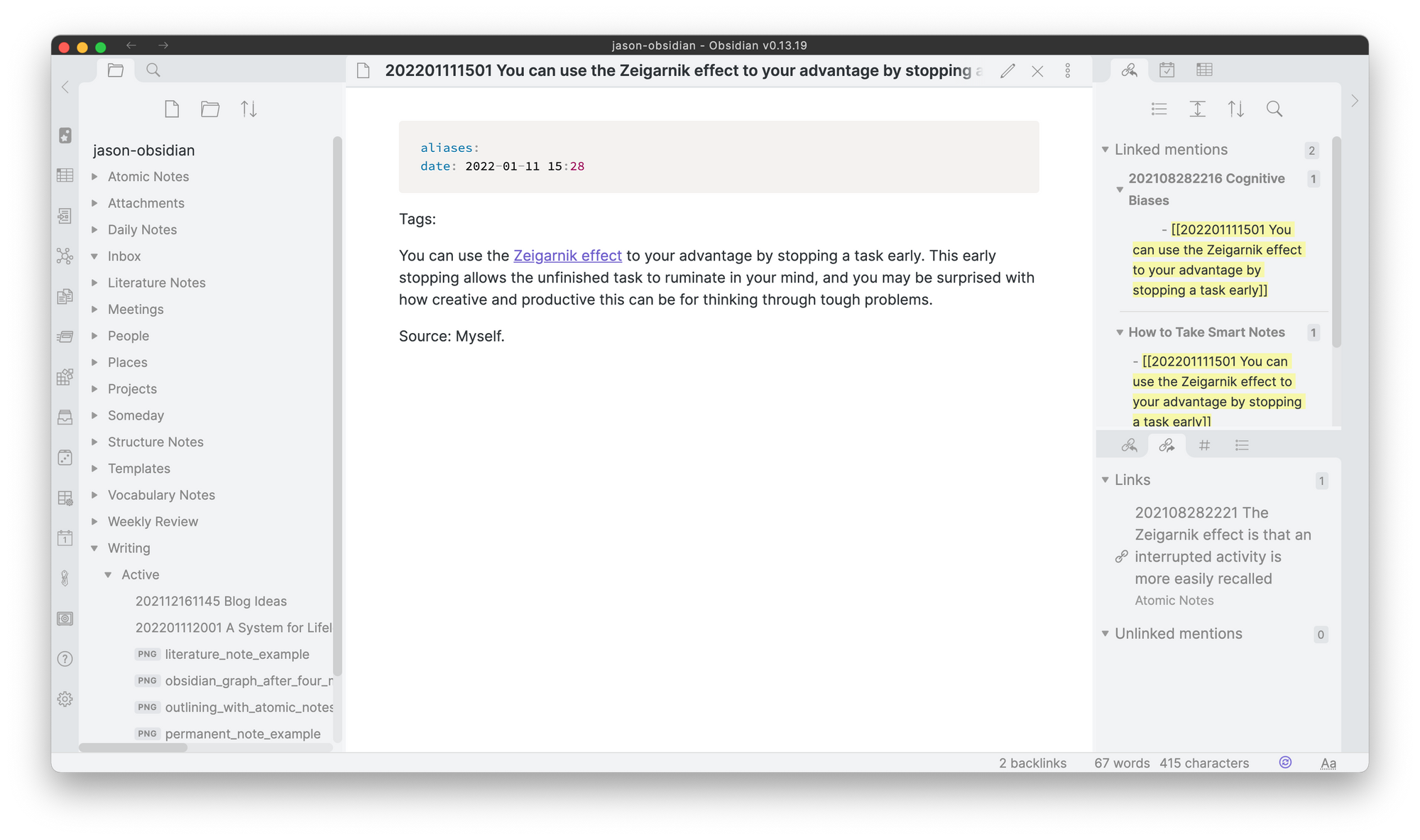
- For a more directed curation session, I use the graph view. It helps me generate ideas because I can visually see the connections (and, more importantly, see what is missing). For example, here is a graph view of the first chapter for a natural language processing book that I am studying.
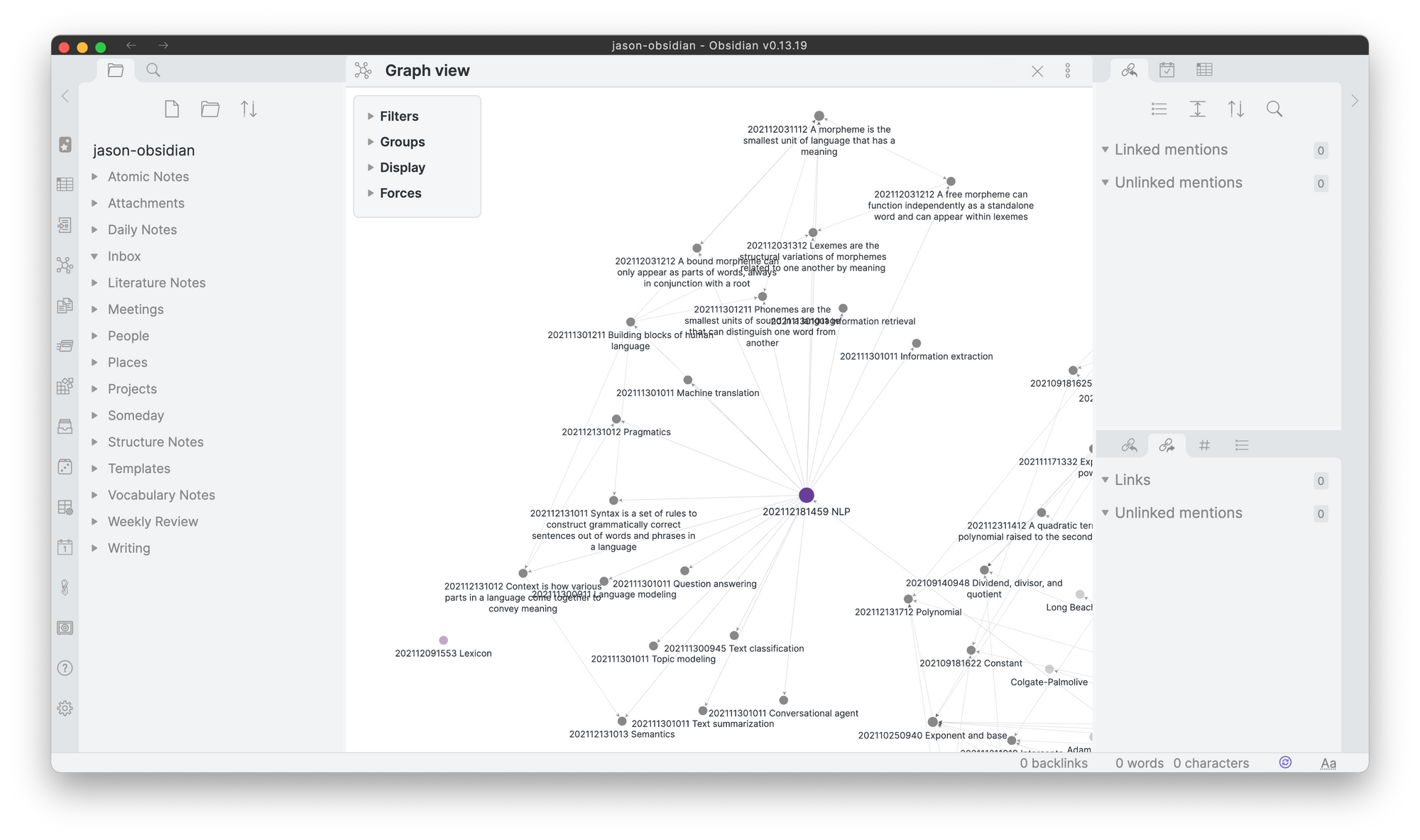
Learn vocabulary with spaced repetition flashcards
While reading, I frequently tag words that I want to understand better. And to retain the knowledge for lifelong learning, I create Anki cards. The Anki syntax in this section is relevant for all notes. Let us walk through creating the below vocabulary note for “Nocebo.”
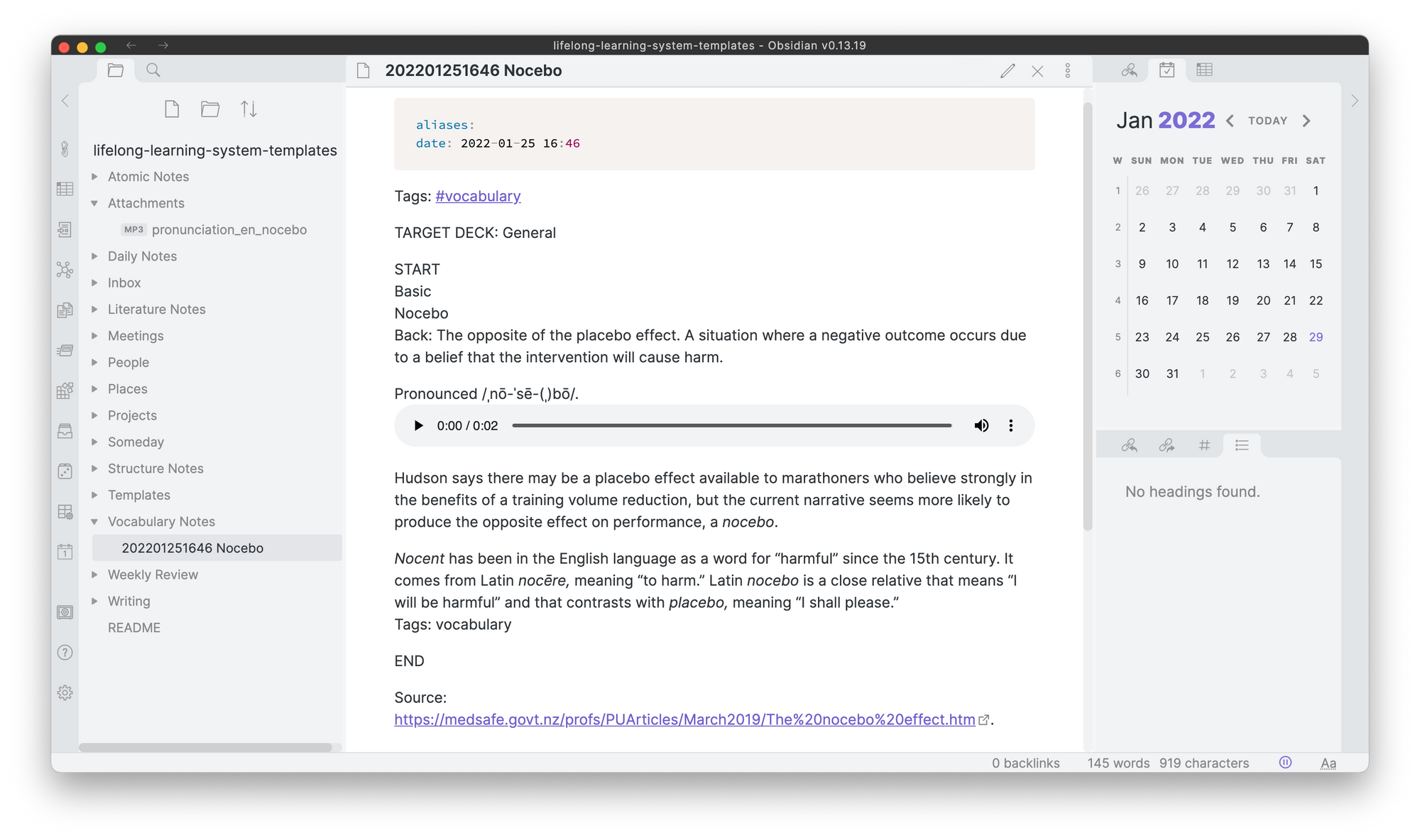
- Create a new note. I use the command
Zettelkasen prefixer: Create new Zettelkasten note. This command adds a timestamp as a prefix, which I apply to every note. - Use the
Templates: Insert templatecommand and choose the vocabulary template. - Fill out the template. A comprehensive Obsidian to Anki commands list is available in the GitHub wiki. I use the following:
TARGET DECK: General: All my Anki notes are in one deck. I prefer to use interleaving while studying. Interleaving involves mixing both old and new problems of different types. Blocking, the typical learning approach, consists of practicing one skill before the next. Interleaving vastly outperforms blocking for retention, and the advantage over blocking is more effective over time. A downside of interleaving is that it requires increased effort. The approach often feels slower and more difficult, especially at the onset. (Pan, 2015). I use tags to differentiate between topics, as necessary.STARTandEND: Syntax for the beginning and end of the Anki card.[Insert note type here]: 99% of my cards areBasic,Basic (and reversed card), andCloze.Back: Signifies the back of the card—the first line after the note type defaults to the front.- Forvo: Downloadable word pronunciations. Download the audio file and drag it into Obsidian.
- Open Anki, and click the
Obsidian_to_Anki - Scan Vaultcommand within Obsidian. If all goes well, you will get a success message. If nothing happens, double-check that you set up Anki correctly so that it can listen for Obsidian. - Open Anki every day. Even five minutes is better than none, and cards start piling up if you miss too many days. The Anki algorithm is fantastic, and I recommend that you leave the default settings alone.
Make a big decision
The decision template is new for me. I want to get better at retrospection and learning from significant decisions. Humans are not near as good as they think they are with assessing their forecasting and judgment accuracy. For a deep-dive into the science, next on my reading list is Superforecasing: The Art and Science of Prediction by Philip Tetlock and Dan Gardner.
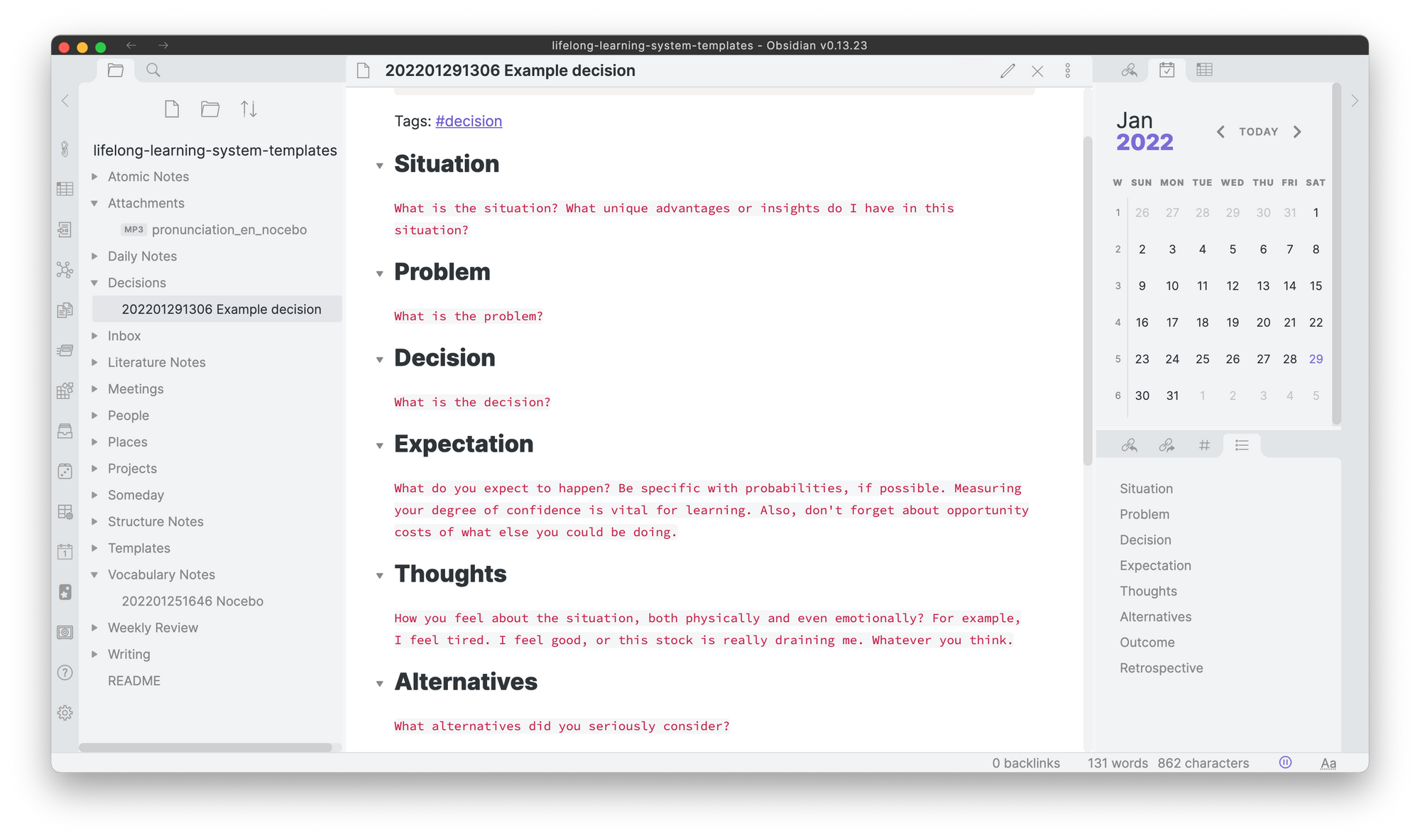
Notes about a person
I have a structure note for many people in my life. It helps me remember children’s names, recommended TV shows, great moments together, and more. Creating a person note is also great for linking people to meetings and ideas. To make a person note:
- Create a new note. I do not use the Zettelkasten prefixer, which adds a timestamp to the note name for people and places notes. It is too annoying when you link to a person’s name, and it shows a long timestamp every time.
- Use the
Templates: Insert templatecommand and choose the general note template. - Edit as you see fit. I find it easiest to create an extensive bullet list. Just be sure to link to other notes and ideas. To create a link in Obsidian, type
[[to open a searchable list of all your notes. The example below shows links between Jane and John Doe.
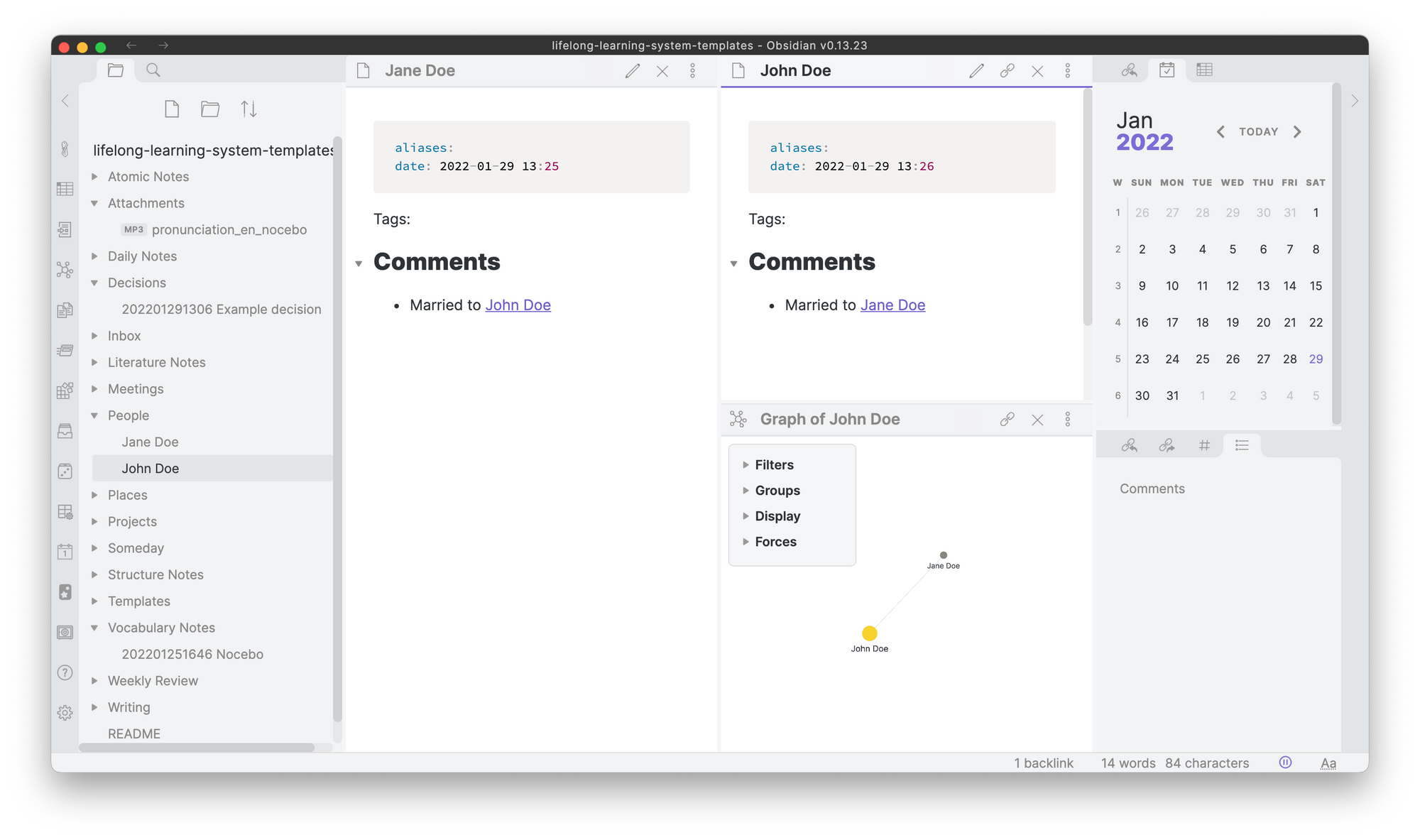
Plan your day
I use the daily notes feature to plan and capture essential things for each day.
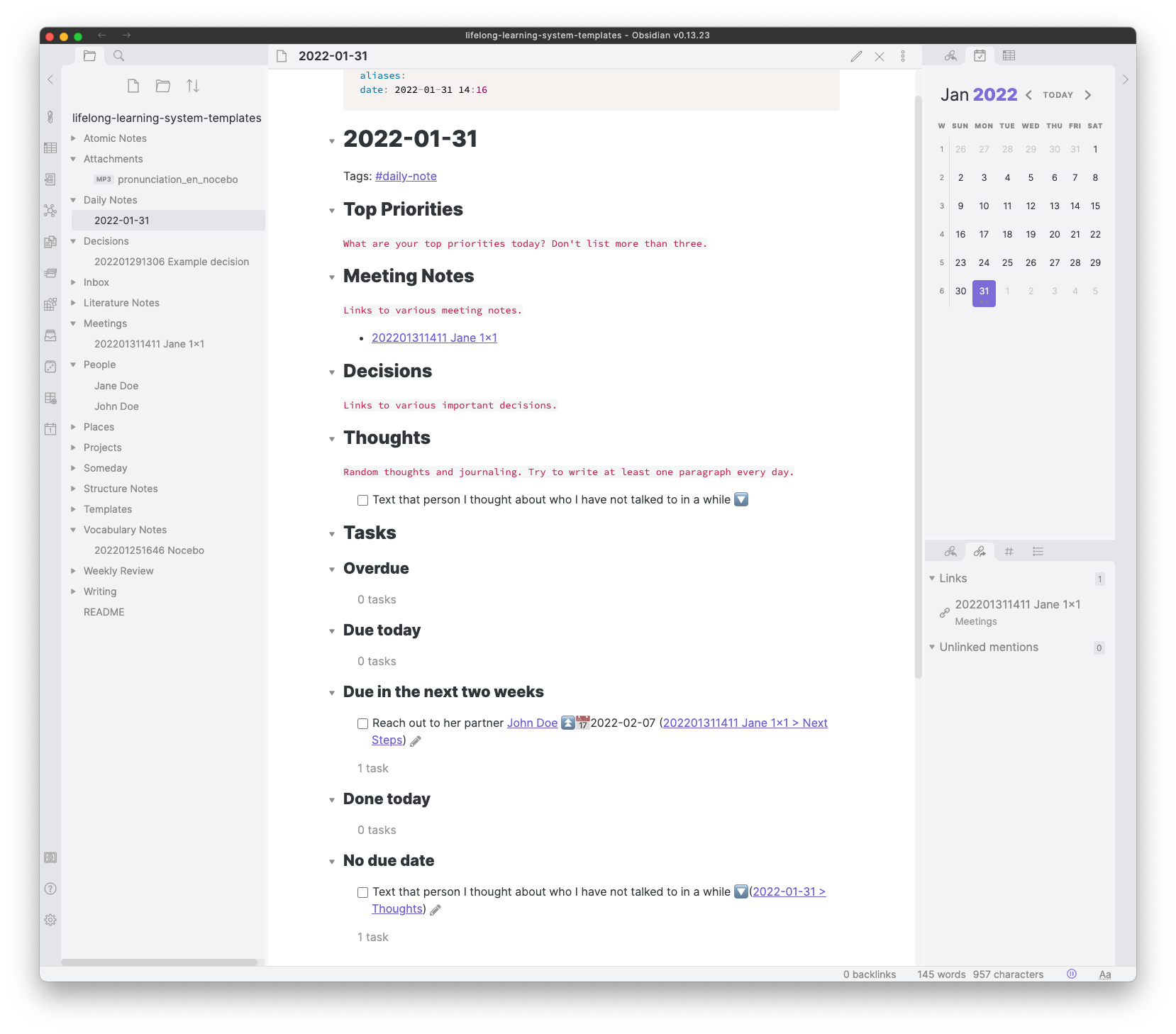
- Open the calendar and click on a day. Obsidian automatically creates a day using the daily note template.
- Each day, I aim to focus on a limited set of priorities. Spending 5-10 minutes every evening to think through my top priorities for the following day works wonders for my ability not to get pulled into immediate but not impactful work.
- I link every meeting note and major decision from that day.
- The thoughts section is suitable for one-off to-do items, ideas you want to come back to later, and anything else you want to capture.
- The tasks section is auto-generated by the Tasks plugin.
Read an article or book
I use Readwise to sync my highlights across multiple sources, including Kindle, Pocket, and physical books.
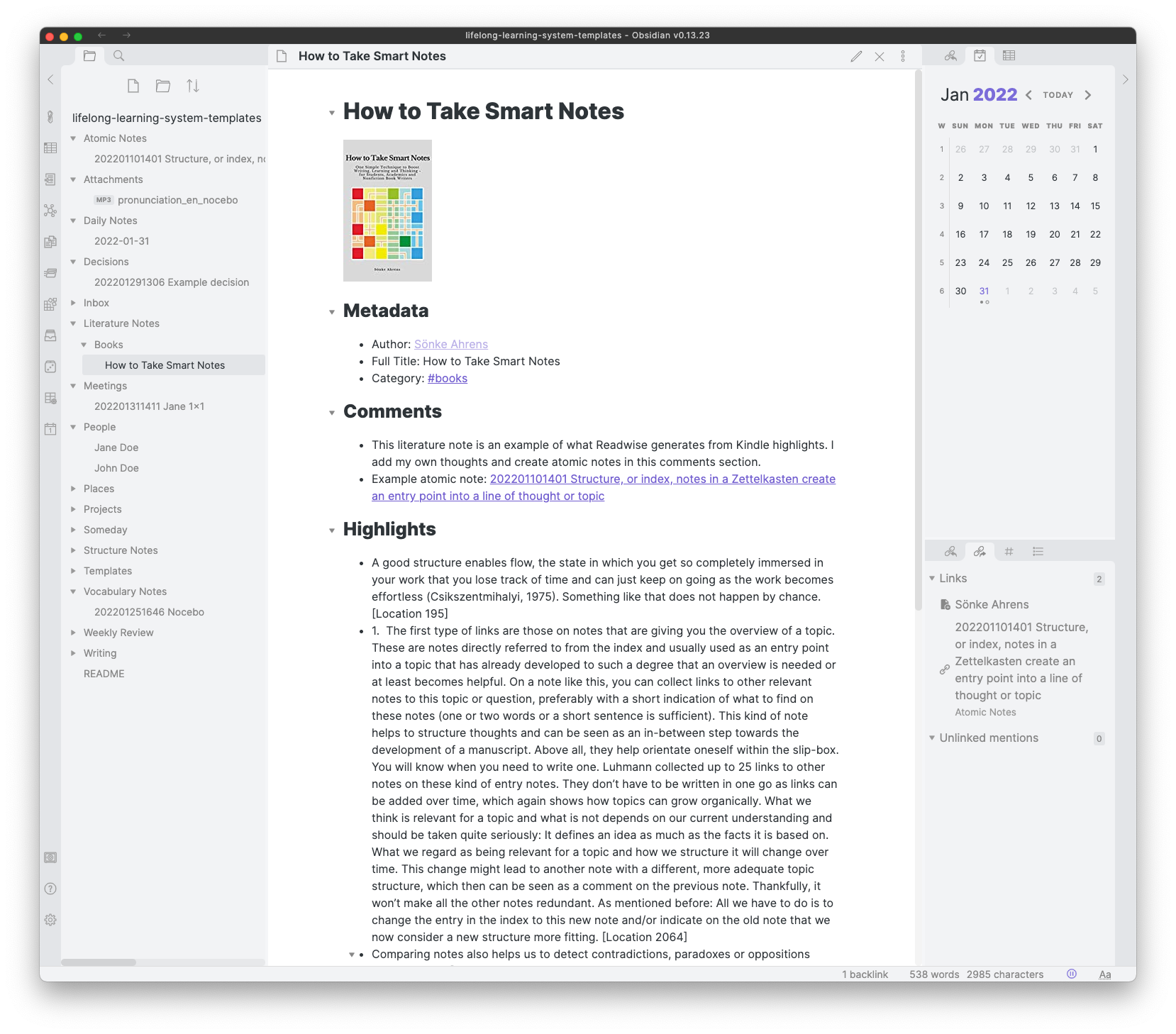
- Readwise imports your highlights into Obsidian with a custom template. Or, you can use the literature template, which I modeled from the Readwise files.
- I set up Readwise to append-only. I then add my thoughts and create atomic notes in this comments section.
- Write notes while you consume and review content, focusing on writing atomic ideas in your own words.
Take a class
Formal courses are more structured than learning from a book or an article. I recently started a class about the science of well-being, and I use a structure note to capture various types of notes each week.
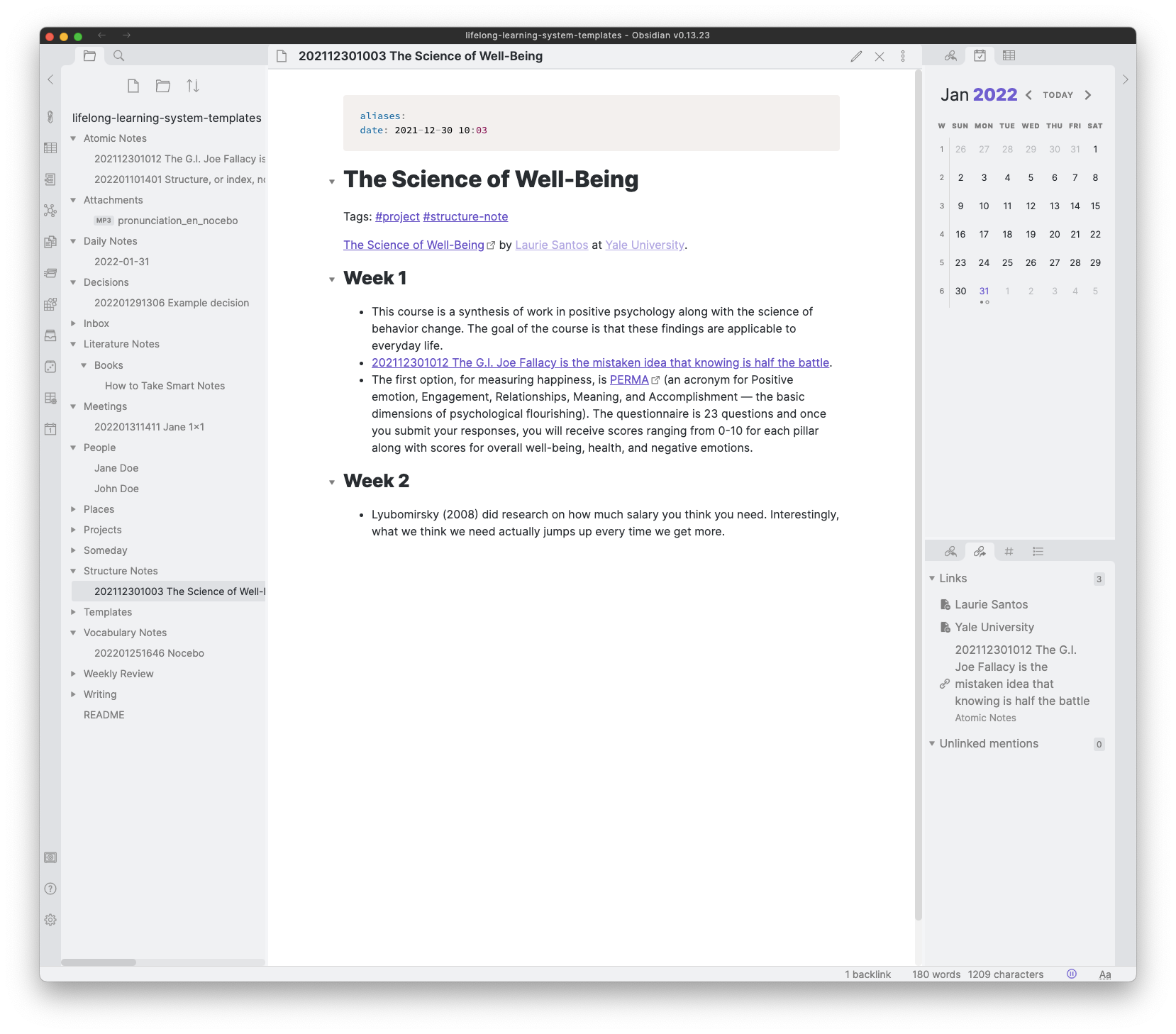
- Create a new note.
- Use the
Templates: Insert templatecommand and choose the general note template. - Create header sections by class, week, etc. Whatever grouping makes sense for your course.
- Most of my initial notes are fleeting and literature notes. When I review, I try to create atomic ideas.
- Depending on the class, I add to-dos in the structure note or use the Kanban plugin.
Weekly review
The weekly review is the cornerstone of the Getting Things Done (GTD) system by David Allen. (Allen, 2002). My system for lifelong learning uses many elements of GTD, although I have modified it slightly for efficiency.
Based on my experience, if the weekly review slips, the whole system fails. Todoist has a fantastic overview for completing a weekly review. (Adegbuyi, n.d.). The power of the weekly review is a forced checkpoint on yourself. It is a chance to reflect on what is working and what is not, and it helps direct your energy and time with intention.
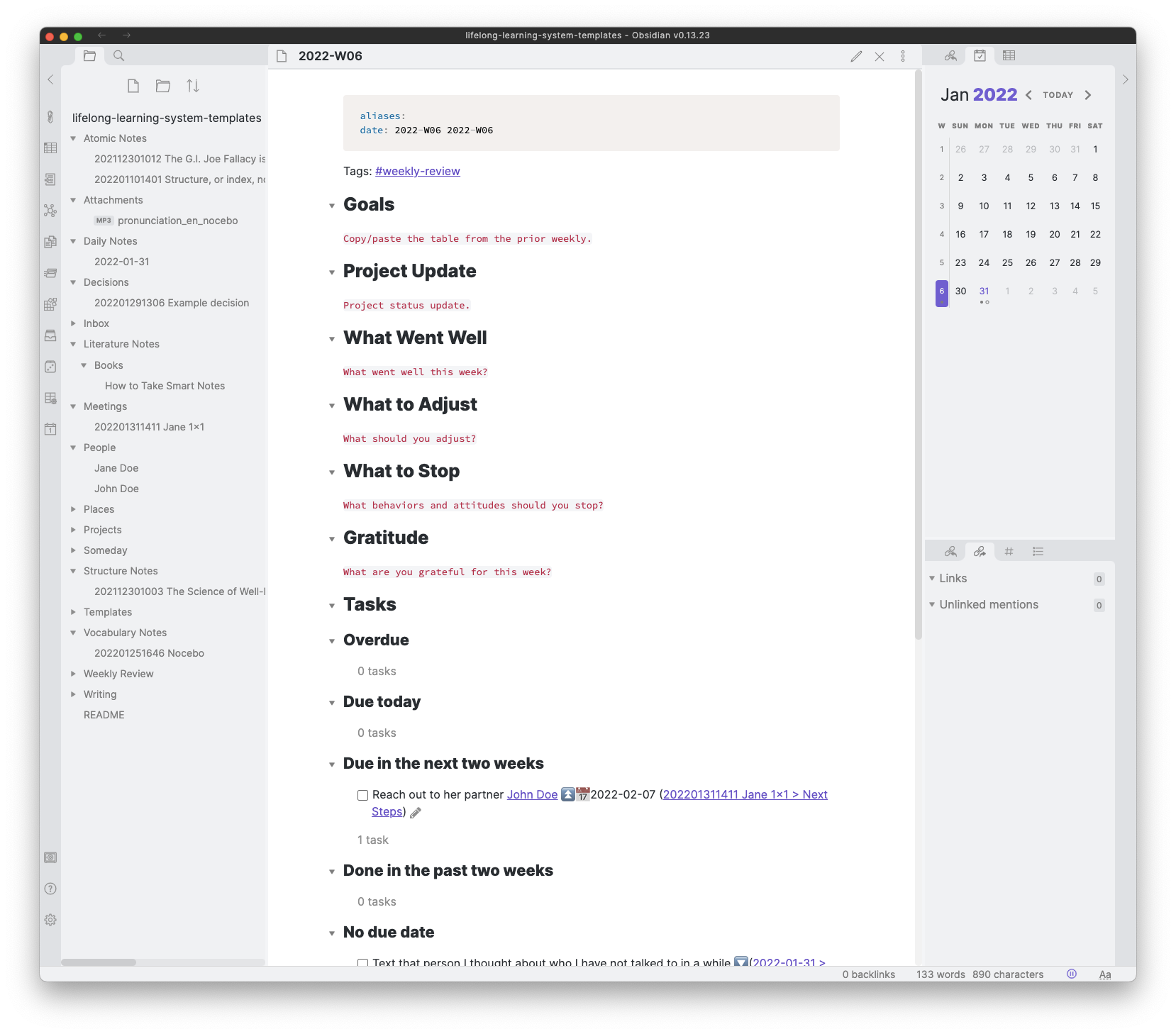
- Open the calendar and click on a week. The week is the small number to the left of the Sunday column. Obsidian automatically creates a note using the weekly review template.
- For goals, I track the following health and productivity metrics. These goals focus on continuous improvement, so I raise the bar slightly higher when a metric reaches a target number. This approach works better for me compared to setting long-term stretch goals. Some weeks you do terrific, and other weeks you fall off the wagon. When that happens—learn why, recalibrate your targets, and keep growing.
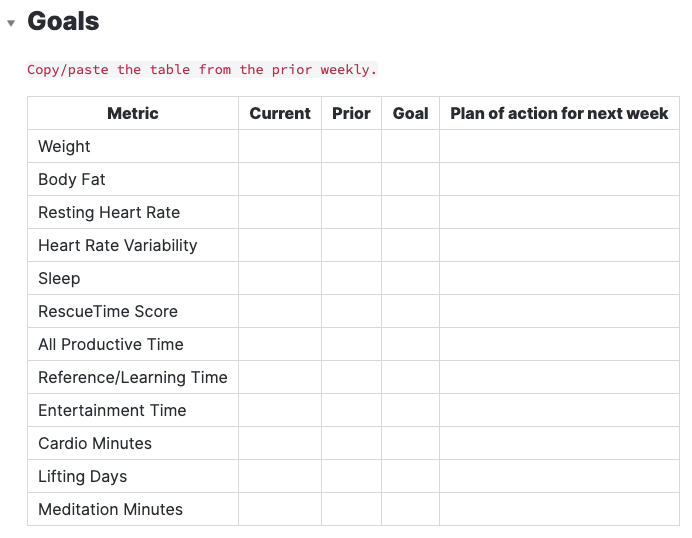
- Project updates are 1-2 sentence summaries of your significant projects.
- What went well, what to adjust, and what to stop are prompts for thinking through your week. This section is where I spend roughly 50% of my time during the weekly review.
- For gratitude journaling, writing once a week is more effective than daily. Sonja Lyubomirsky and her colleagues found no benefits for daily journaling, while weekly journaling boosted happiness. (Marsh, 2011). Go for depth instead of breadth, and get personal in your gratitude journal. Elaborating in detail, and focusing on people instead of things, carries more benefits. An effective way of stimulating gratitude is also reflecting on your life without specific blessings.
Work meeting
I am pretty surprised how well this system works for meetings too.
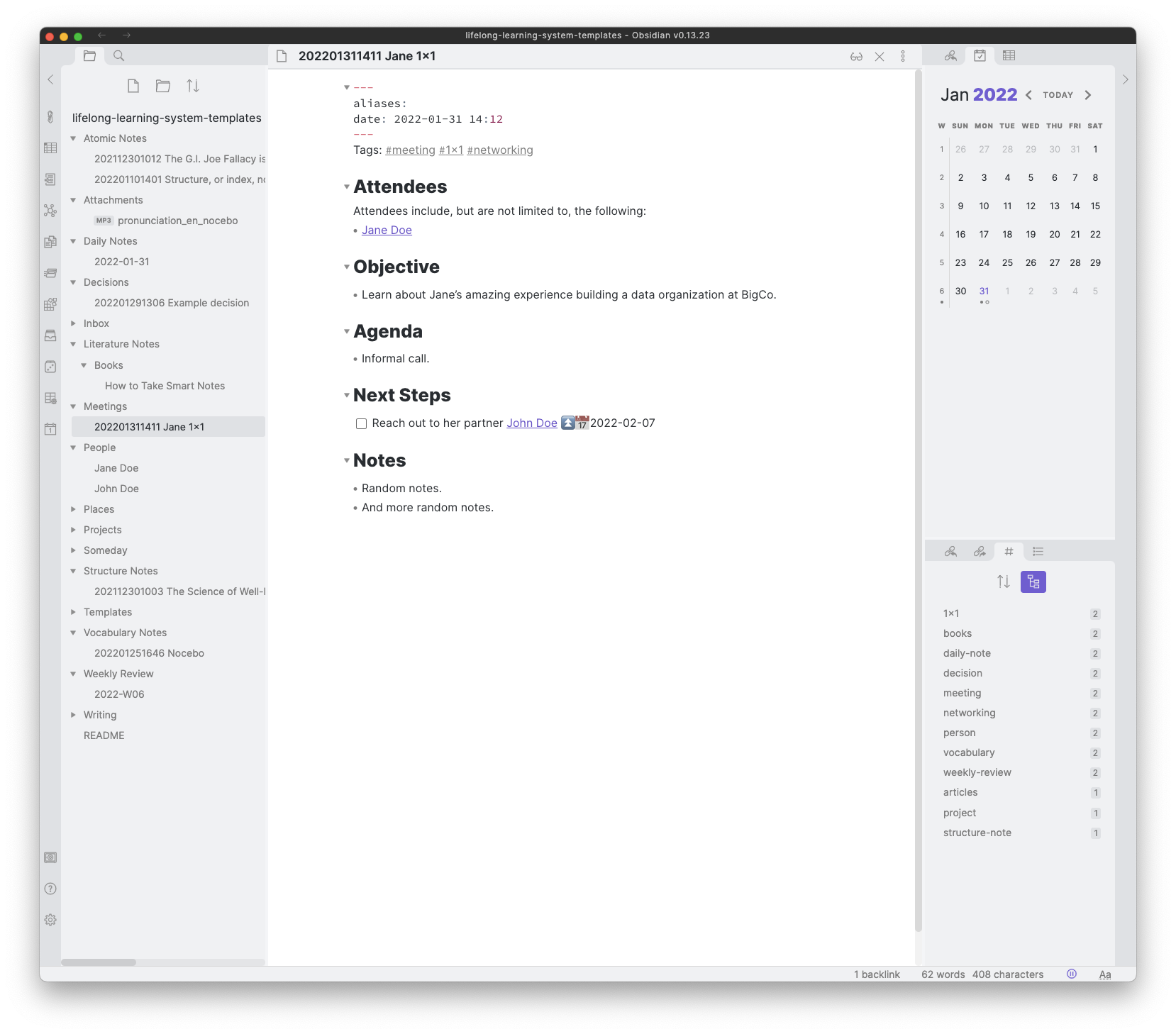
- Create a new note.
- Use the
Templates: Insert templatecommand and choose the meeting template. - If you cannot use Obsidian during a meeting, I would still use this template for briefly summarizing your meaningful discussions after the fact. I spend too much time in meetings in a leadership role, yet they do not seem to go away. However, I can control how effective these meetings are, so I am conscientious about objectives, agenda, and next steps.
- I consider meeting notes to be the equivalent of a literature note. They are written in your own words, brief, and generally summarize an event. And do not worry about creating too many atomic ideas out of these notes. You will likely research something later based on something you heard and then add your findings as atomic ideas.
Write an article
I could not believe it when I started to write this article, the most extended essay I have written since graduate school. As I mentioned earlier, Niklas Luhmann found he was thinking with the system by linking atomic ideas to each other, reducing writing friction. It sounded like the typical, stale advice such as “wake up early” or “follow your dreams” that you often hear from successful people.
Below is an embarrassingly early draft, composed entirely with atomic ideas! It worked.
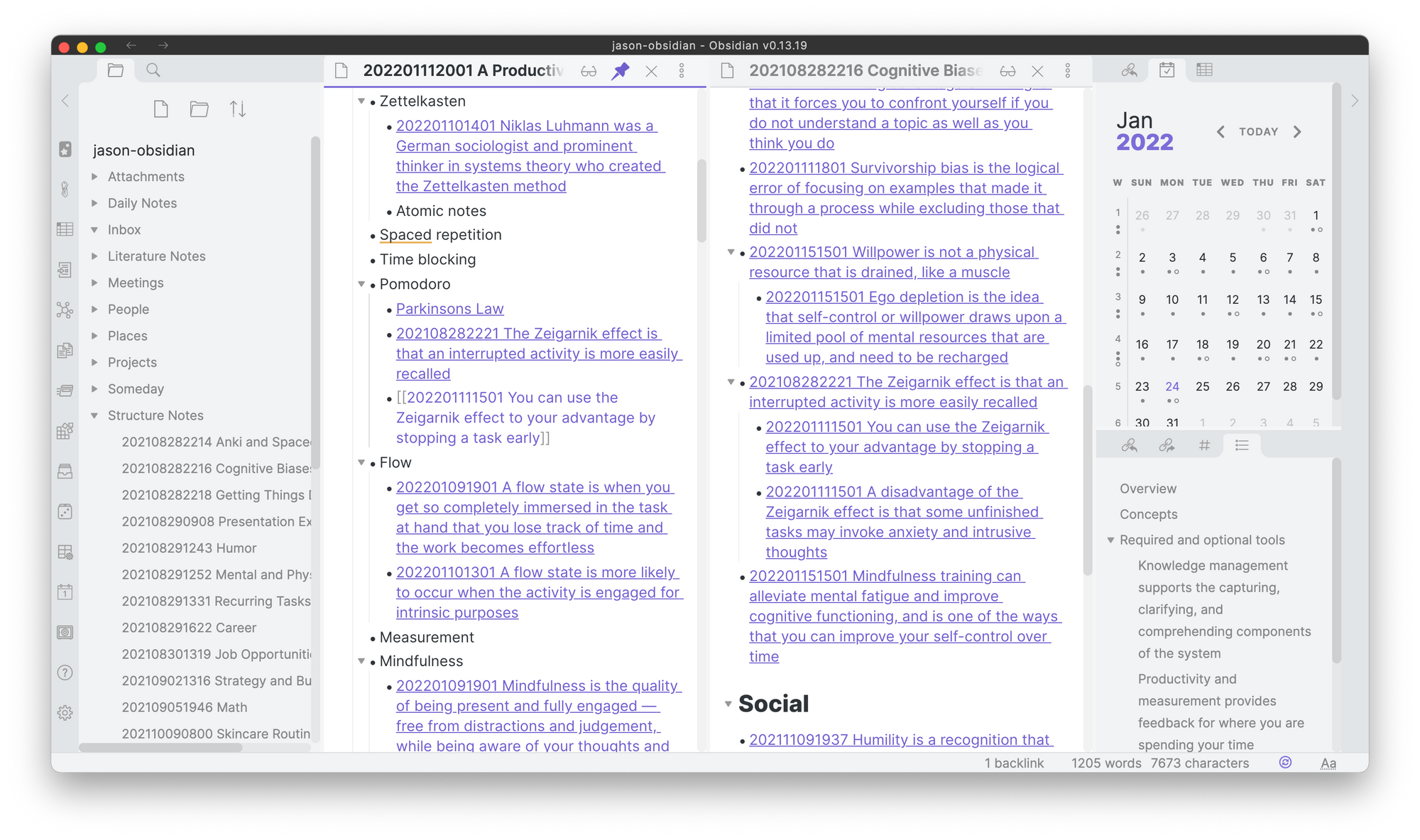
As you create atomic ideas and link them to each other, and structure notes, you begin to develop your topics and lines of thinking from the bottom-up. See what connects, what is missing, and what needs clarification. Continue to build upon your knowledge and follow interesting paths to maintain motivation. As notes coalesce into topics, it is clearer to decide on a topic to write about based on what you already know. (Ahrens, 2017).
Turn your notes into a rough draft by linking many notes in one document. Continue iterating on your notes and the overall story until you have a sound argument. At this point, you may still have a long list of bullet points. And finally, create the final version by converting the long list of bullet points into a coherent written piece.
Bonus Tip: Practice Mindfulness
Mindfulness is the quality of being present and fully engaged — free from distractions and judgment while being aware of your thoughts and feelings without getting caught up in them. (Headspace, n.d.). Mindfulness training can alleviate mental fatigue and improve cognitive functioning and is one of the ways that you can improve your self-control over time. Think of a mindfulness break as “clearing your brain’s cache.” (Henselmans, 2021).
I got into mindfulness during the pandemic and wished I had years ago. It helps me with anxiety and sharpens my thinking. Perhaps most surprising to me is how it can sometimes turn a bad day into a good one after taking a 10-20 minute meditation break.
Ideas for Further Research
I feel like I am scratching the surface of what is possible with this system. Some ideas that I have for further research are:
- Use Zotero for managing references and citations.
- Query Obsidian like a database with the Dataview plugin.
- Go through the resources at Zettelkasten.de. The author is passionate about the Zettelkasten system and offers an online course.
- Research why writing goals such as 500 words per day are not practical. I keep seeing this evidence anecdotally, and I wonder if there is published research out there.
- Read Deep Work by Cal Newport and incorporate relevant ideas.
To close, I believe that time is humanity’s most valuable asset. And thank you for spending some of your valuable time with me. I hope this was helpful!
References
- Adegbuyi, F. (n.d.). The Weekly Review: A Productivity Ritual to Get More Done. Todoist. Retrieved January 25, 2022, from https://todoist.com/productivity-methods/weekly-review.
- Ahrens, S. (2017). How to Take Smart Notes: One Simple Technique to Boost Writing, Learning and Thinking – for Students, Academics and Nonfiction Book Writers. CreateSpace Independent Publishing Platform.
- Allen, D. (2002). Getting Things Done: The Art of Stress-Free Productivity (Reprint ed.). Penguin Books.
- Background - Anki Manual. (n.d.). Anki Manual. Retrieved January 24, 2022, from https://docs.ankiweb.net/background.html.
- Clear, J. (2018). Atomic Habits: An Easy & Proven Way to Build Good Habits & Break Bad Ones (Illustrated ed.). Avery.
- Gilbertson, J. (2022, January 23). A Virtuous Cycle vs. Walled Gardens for Lifelong Learning. Jason Gilbertson. https://www.jasongilbertson.com/a-virtuous-cycle-vs-walled-gardens-for-lifelong-learning-2/.
- Headspace. (n.d.). What Is a Flow State and What Are Its Benefits? Retrieved January 24, 2022, from https://www.headspace.com/articles/flow-state.
- Henselmans, M. (2021). THE SCIENCE OF SELF-CONTROL: 53 Tips to stick to your diet, be more productive and excel in life. Independently published.
- Marsh, J. (2011, November 17). Tips for Keeping a Gratitude Journal. Greater Good. Retrieved January 24, 2022, from https://greatergood.berkeley.edu/article/item/tips_for_keeping_a_gratitude_journal.
- Pan, S. C. (2015, August 4). The Interleaving Effect: Mixing It Up Boosts Learning. Scientific American. Retrieved January 29, 2022, from https://www.scientificamerican.com/article/the-interleaving-effect-mixing-it-up-boosts-learning/?utm_source=pocket_mylist.
- Perell, D. (n.d.). Why You Should Write. David Perell. Retrieved January 24, 2022, from https://perell.com/essay/why-you-should-write/.
- Sascha, S. (2020, October 27). Introduction to the Zettelkasten Method • Zettelkasten Method. CC:BY-NC-SA Christian Tietze, Sascha Fast. Retrieved January 26, 2022, from https://zettelkasten.de/introduction/.
- Scroggs, L. (n.d.-a). The Complete Guide to Time Blocking. Todoist. Retrieved January 24, 2022, from https://todoist.com/productivity-methods/time-blocking.
- Scroggs, L. (n.d.-b). The Pomodoro Technique — Why It Works & How To Do It. Todoist. Retrieved January 24, 2022, from https://todoist.com/productivity-methods/pomodoro-technique.
- Wikipedia contributors. (2021, December 29). Metcalfe’s law. Wikipedia. Retrieved January 24, 2022, from https://en.wikipedia.org/wiki/Metcalfe’s_law.
- Wikipedia contributors. (2022a, January 14). Niklas Luhmann. Wikipedia. Retrieved January 24, 2022, from https://en.wikipedia.org/wiki/Niklas_Luhmann.
Footnotes
[1]: Start with a baseline of 100. One percent better, each day for a year, equals \(100*(1+0.01)^{365} = 3,778\). One percent worse, each day for a year, equals \(100*(1-0.01)^{365} = 0.03\).


